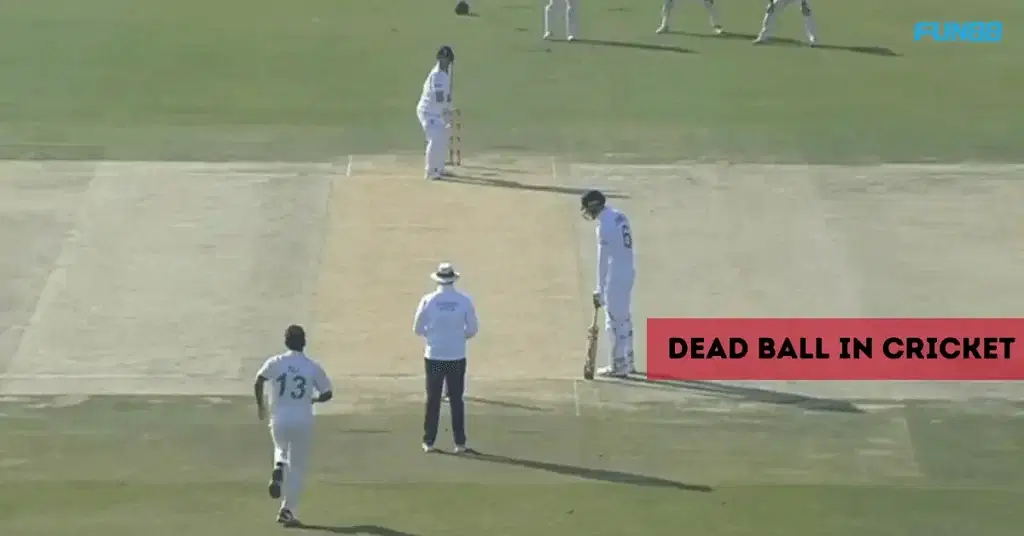A game of cricket can drastically change with every run, swing or catch. It is quite a complex sport with as many as 40+ laws explaining all the features of playing the cricket game. The cricketing laws are owned and maintained by the private Marylebone Cricket Club (MCC) in Lord’s Cricket Ground, London. The Laws include a mysterious rule known as the ‘Dead Ball’ that could turn out to be influential in the course of a match. A dead ball in cricket is a common term that has a vital role to play. But to date, the dead ball rule remains complicated and has caused several on-field controversies over the years.
What is a Dead Ball In Cricket?
In cricket, a dead ball situation arises when the umpires briefly stop play and declare the ball dead. This means the ball is not in play anymore. In other words, the rule decides whether the ball is in play or not. During the dead ball period, batters are not allowed to score runs, they cannot be dismissed, and fielders cannot make a play to get a batter out.
The dead ball period is usually observed after six legal deliveries in an over are bowled and the bowling side is preparing for the next over.
In this period, the bowling side switches ends, allowing their keeper to discuss with the players to strategize for their next over. Meanwhile, the batters take a moment to reset their minds and prepare for another over’s challenge.
The break due to a dead ball in cricket may also break the game’s momentum. But it will definitely benefit one side. If a batter was in flow and hitting across the park, the play’s halt because of the dead ball could break the striker’s momentum, allowing the bowler to rectify their mistakes.
The dead ball rule states when the ball is in play and when it is not. The Law also defines scenarios in which a bowler will be given another delivery to bowl.
Dead Ball’s History
The first Law of cricket was established supposedly in 1774, but the term ‘dead ball’ did not come into the cricketing picture until 1798, of course, in England. Back then, the dead ball concept stated that if a fielder stopped the ball with their hat, he received a penalty of five runs.
It was finally in 1884 when the dead ball rule was used to address circumstances where the ball became trapped in players’ clothing or equipment. Over the years, the law involving the dead ball rule has evolved multiple times to accommodate various scenarios.
This shows how much the game of cricket has grown, and laws have been tweaked accordingly to cater to its increasing intricacies.
Related Read: No Ball in Cricket: Rules and Their Types
Common Instances Leading To Dead Ball
When a wicket falls: When a batter is dismissed through a catch, stumping or bowled, the umpire declares a dead ball so the player cannot complete a run or score additional runs after getting out.
End of an Over: The dead ball period comes into action after six legal deliveries are bowled in an over. It brings in a small pause in the game as a new bowler may come into action, while it also allows all the 13 players on the field to take a moment and reassess themselves.
Scheduled Breaks: Cricket has a number of breaks during matches, such as lunch, tea and drinks. When these breaks, which are taken after a certain number of overs or at a specific time, result in a dead ball.
Automatic Dead Ball
MCC’s Law 20 of Cricket specifically explains a series of situations when the ball will become dead. Multiple clauses further reference this law:
According to Law 20.1.1, a ball becomes dead when it is “finally settled in the hands of the wicketkeeper or of the bowler,” and the umpire has the sole authority to decide so. Other circumstances included in this clause are the ball being deemed dead when “a boundary is scored” and when “a batter is dismissed.” In the latter clause, the ball is declared dead from the moment of the incident, leading to the latter’s dismissal.
The ball is declared dead automatically if the above-mentioned situation arises. The other scenarios that are also counted in the automatic Deadball category are:
- On the call of ‘Time.’
- On the call of ‘Over.’
- On the ball reaching the boundary.
- On the ball pitching over the boundary.
- The ball lodging in the dress of the batter.
- The ball lodged in the dress of the umpire.
- On the call of ‘Lost ball.’
- On a penalty being awarded for an illegal fielding act.
- On the dismissal of a batter for any reason.
- When the ball lodges in the protective helmet worn by a member of the fielding side.
Non-Automatic Dead Ball
An on-field umpire signals a Dead Ball when:
- The umpire interferes in a case of unfair play (disturbing or obstructing a batter).
- A severe injury to a player or umpire occurs.
- The umpire is convinced that the batter on strike has an adequate reason for not being ready to receive the ball and makes no attempt to play it.
- The bowler drops the ball accidentally before delivery or does not leave their hand for any reason.
- The bowler throws the ball towards the striker’s end before entering his/her delivery stride.
- If the striker is distracted by any noise or movement or in any other way while preparing to receive a delivery. This shall apply whether the source of the distraction is within the game or outside it.
- Either one or both bails fall from the striker’s wicket before he receives the ball.
- The umpire leaves their normal position for consultation.
- The umpire is satisfied that the ball in play cannot be recovered.
If the umpire considers that either side has been disadvantaged by a person, animal or other object within or over the field of play, the boundary shall be awarded. However, if both on-field umpires agree that the ball would have reached the boundary regardless of the intervention, the boundary shall be awarded.
Can the Dead Ball Be Recovered?
Once the umpire deems a ball dead, the decision cannot be revoked to bring the ball back into play for that delivery. According to Law 20.7, if a Dead Ball is called before the striker receives a delivery, the bowler shall be allowed an additional ball. The ball will be repeated in the over even if the striker has not had an opportunity to play it.
If the umpire declares the ball dead after the striker receives a delivery, the bowler shall not be allowed an additional ball unless a ‘no ball’ or ‘wide’ has been called.
The ball is not declared dead when:
- The ball hits an umpire (unless it gets trapped in his/her dress).
- The wicket is broken or struck down (unless a batter is out thereby).
- An unsuccessful appeal is made.
- The wicket is broken accidentally either by the bowler during their delivery or by a batter while running.
- The umpire has called “no ball” or “wide”.
Meanwhile, the umpires also have the power to call dead balls at their discretion. This comes into the picture during events for which there is no written rule in the Laws of Cricket. One such notable example goes back to 2005.
Australian batter Michael Hussey smashed the ball to the retracted roof at the Telstra Dome. What would have been six in an open stadium was ruled a dead ball by the on-field umpire, and no runs were awarded.
Umpire’s Role In Declaring a Dead Ball
The on-field umpires have a massive role in declaring a dead ball in cricket, as they also have to ensure there is no confusion among the players or for the fans watching from the stands. Their alertness and fairness in decision-making regarding this particular rule will also help maintain the game’s integrity. It will further convince the players that they can rely on the umpires to make a correct decision.
Umpire Signals for Dead Balls
One of the most used deadball signals by on-field umpires is crossing their hands in front of them with closed fists. This signal immediately indicates that the ball is no longer in play, and the players must not perform any further action.
The signals used by the umpires are crucial as they must ensure that players, regardless of their positions, understand that the ball has been declared dead. It also keeps any confusion at bay and maintains sanity in the game.
Also Read: Leg Byes Run in Cricket: Rules & Scoring
Controversial Dead Ball Incidents
A popular incident happened because of a dead ball during a T20 World Cup match between India and Pakistan in 2022. During India’s chase in Melbourne, Virat Kohli was bowled, but the umpire did not signal out and instead declared it a dead ball.
As per Law 20.1.1, a ball can also be called a dead ball even when a batter is dismissed, as the ball will be deemed dead from the instant of the incident causing the dismissal.
The controversial dismissal of English batter Jonny Bairstow during the latest edition of The Ashes in the UK led to a fresh debate over the deadball rule. The Yorkshire batter ducked under the last delivery of the 52nd over, bowled by Australia’s Cameroon Green, and the ball safely landed in the hands of wicketkeeper Alex Carey.
Assuming the ball was dead and the over was complete, Bairstow walked out of his crease towards non-striker Ben Stokes. The alert Carey, however, instantly threw the ball towards the stumps, and the direct hit sent back Bairstow, who was well short.
The Laws clearly state that the ball is live until the “fielding side and both batters at the wicket” think otherwise.
Years ago, Indian spinner Harbhajan Singh was on the receiving end of the Dead Ball rule. He was denied a wicket when the umpire declared a dead ball as the batter had pulled away just as Harbhajan was about to deliver the ball. The incident led to a heated debate about the fairness of the rule.
In another incident, a batter suffered because of the dead ball rule. In an international match between England and South Africa, when a fielder threw the ball from the boundary straight at the wicketkeeper’s pads, the umpire declared it a dead ball. That meant the batters could not take any additional runs.
In 2011, English player Ian Bell was given out in a controversial manner during a Test against India at home. Thinking that the ball was dead after reaching the boundary, Bell left the crease to head in for tea. Unfortunately, the ball never reached the boundary and was immediately thrown by an Indian fielder, who took off the bails. The umpire rightly declared Bell out.
However, during the tea break, the Indians revoked their appeal, and Bell returned to play. Bell scored his first double hundred in the series, a Test best of 235. For making this decision, the Indian captain, MS Dhoni, won the ‘Spirit of Cricket’ award at the 2011 ICC Awards.
Conclusion
The concept of dead balls in cricket may seem straightforward, but it is not. The dead ball law has many branches, and therefore things will be easier on the field if players are aware of and fully understand each rule. If players understand and respect the dead ball rule, it will help them understand that it is a great time for them to discuss new strategies. It will also reduce any chances of ugly arguments and maintain the fairness of the game.
Star it if you find it helpful.

